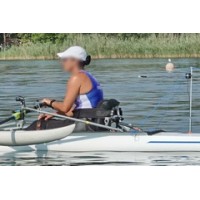Biomechanics of Para-rowing

While most of our publications have been focused on Olympic rowers, we frequently receive questions about Para-rowing. The amount of the data we have on Para-rowers is not large, so we present a case study here on the comparison of Olympic and Para-rowers in singles.
Four single scullers of International level, two from Olympic categories and two Para-rowers (male and female in each category), were tested with the BioRow system.
The Olympic athletes were specifically selected to have similar body height and weight to the Para-rowers (only 3-5% difference). The rigging was very different: inboard was 26% shorter for Para-rowers, oar length – 12% and span – 15% shorter. This means that the actual static oar gearing was 28% heavier for Para-rowers than for the Olympic rowers (2.665 and 2.081 respectively). To have the same gearing as Olympic rowers, Para-rowers would need to have a 36cm shorter oar length (about 2.16m), with the same inboard as before.
The average rowing speed was 18.7% slower in Para-rowers – a smaller difference than between World best times (26%). So, the Para-rowers performed relatively better than the Olympic rowers in this case study.
Usually, slower rowing speeds correspond to lighter gearing, e.g. gearing in pairs and singles is lighter than in eights and quads. However, here an opposite relationship was found: the gearing used by Para-rowers was significantly heavier at a much slower speed than the Olympic rowers. To achieve the same ratio of gearing/speed with the same inboard, Para-rowers should use an oar length of about 1.92m.
Having similar velocities of heavy body parts, Para-rower maximal arms velocity was roughly half the speed than that of Olympic-class rowers, which is a consequence of heavier gearing and slower handle velocity. This fact could be a point to think about improvements, because this slow, nearly static arms drive could be inefficient.
Analysing 18% difference in speed between Olympic and Para-rowers, two reasons could be identified:
- 31% lower rowing power, which was mainly related to shorter drive length and slower handle velocity;
- 40% higher Drag Factor, which could be explained by a heavier and wider boat plus extra resistance of under-rigger floats.
Interestingly, the blade efficiency was 1.8% higher for Para-rowers, because of heavier gearing, which decreases relative pressure on the blade and its slippage.
To conclude: biomechanics of Para-rowing have many similar features with open events: force curves, oar angles, body mass movement, even the Catch Factor.
The main differences were found in shorter drive length, shorter catch angles, and lower rowing power, which together with higher drag resistance resulted in slower rowing speed.
This is a short version of this Newsletter. Full text is available for BioRow members: https://biorow.com/membership/
 ©2023 Dr. Valery Kleshnev
©2023 Dr. Valery Kleshnev



